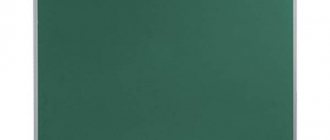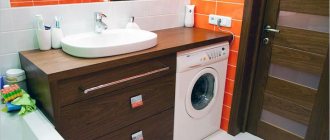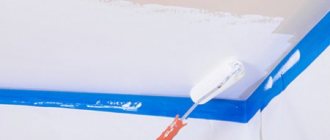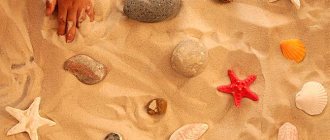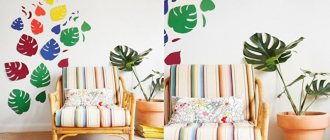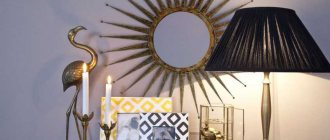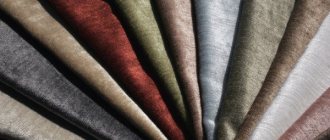Chalk boards are becoming increasingly popular in modern interiors. Firstly, it is very convenient - by hanging such a board in the kitchen, you can write short reminders to yourself about what you will buy and what you should not forget to do.
For a family with children, this is also an irreplaceable entertainment and your wallpaper will remain intact. Chalk boards are used to decorate parties and birthdays, and adults also love to draw on it and leave wishes.
You can buy such a board ready-made and it costs from 10 to 100 dollars, but why? If it’s very simple, you can make a chalk board at home from any base and acrylic paint.
Choosing paint for the board
There are special paints - they are called “for chalkboards”, but you need to spend money on them.
- The peculiarity of such paints is that they are the same acrylic, BUT they contain small solid particles that allow the chalk to linger on the surface of the board.
- If you add any abrasive material to the paint, for example, gypsum, grout, cement, then it is precisely its elements that will make ordinary acrylic paint suitable for painting on it.
- We offer the simplest master class for making such paint using alabaster and black acrylic.
Paint or make?
If you have definitely decided that you want to designate a wall for a slate board, you should carefully prepare for this process. First, we buy a special aerosol paint that is suitable for painting walls. Secondly, you should prepare the surface. To do this, we first sand it with sandpaper, then plaster it and apply several layers of paint. Let it dry. This DIY slate board is created with minimal cost and effort. By the way, it can be done not only in the kitchen, but also in any other room, even a nursery, where kids can practice drawing and learning to write, for example.
Choosing a board base
You can choose absolutely any base, it could be:
- Any plywood
- Any piece of board, table top or piece of old facade
- Mirror glass or
- Cardboard - take apart the old cardboard box and the base is ready
If you choose wood as a base, then do not forget to sand it and treat it against corrosion - read more about processing wood, cuts and branches here.
Origins of a fashion trend
It is noteworthy that the use of slate boards began in restaurants, cafes, and bars. It is in these establishments that they write the weekly menu on them, talk about possible promotions, discounts, new dishes, or leave certain messages to passers-by. Thus, the touching children's tradition gradually moved into the sphere of entertainment and service. However, slate boards are also ideal for home interior design.
Master class: how to make a chalk board
The fastest and easiest way to make a board is to use any cardboard as a base; it does not need to be processed before painting. In addition, after practicing on it, you can move on to larger surfaces.
Ingredients and Tools
- 2 tablespoons alabaster
- 1 tablespoon water
- 3 tablespoons black acrylic paint
- cardboard
- tassel
- dry rag and chalk
Manufacturing process
- We take alabaster and water in a ratio of 1 to 2, mix and rub the lumps well until a uniform thick mixture is obtained.
- Pour paint into the container. There should be 3 times more paint than alabaster. Add the prepared mixture of alabaster and water to the paint and mix thoroughly so that there are no lumps left.
- If you don’t mind and have a technical attachment, you can do this using a mixer. It's faster and more reliable. But if you stir with a spoon, it doesn’t take long either - the lumps will disperse in 2-3 minutes.
If the mixture is too thick, add a little more water, since acrylic paints from different manufacturers have different densities.
- In any case, our mixture with alabaster and paint should be easily applied with a brush, but also not flow.
- After this procedure, our mixture must be quickly applied to the base, since leaving it for a long time is not the best option - it begins to thicken.
- Take a wide brush and apply it to the cardboard.
For longevity, apply 3 coats of paint to the chalkboard . Let the paint dry completely between coats. After the third layer has dried, it is recommended to rub chalk over the entire surface to harden it , and then wipe the chalk with a dry towel.
TIP: The cardboard may sag slightly after applying the paint, but it will straighten out once it dries.
Insert the cardboard into any photo or painting frame and your board is ready!
DIY school magnetic board
No matter how hard I tried to write only about travel, one way or another the site turns into a blog about how to be a fun mom) Traveling with a child, playing, working and just a mom of all trades. It’s precisely this test for crookedness that I’ve been taking all the time lately, when I’ve taken on the task of arranging the house, and in particular the child’s room. After a trip to India, I got a second wind and started to come up with a bunch of ideas for the nursery. One of these ideas is a magnetic board for children, or rather one child and his young guests, on which you can sculpt magnets and draw with chalk.
I made it for my son with my own hands back in December. And the time has come to tell you how I succeeded. I have been dreaming about a large magnetic board for a child for a long time. We had all sorts of magnetic construction sets that could be used perfectly on such a board. The small ones didn’t suit me at all, there’s not much room to move around in a small square, it’s boring :/
And the time has come to tell you how I succeeded. I have been dreaming about a large magnetic board for a child for a long time. We had all sorts of magnetic construction sets that could be used perfectly on such a board. The small ones didn’t suit me at all, there’s not much room to move around in a small square, it’s boring :/
When I started monitoring this topic, I realized that large boards are not cheap at all. Plus, if you have a huge board, then you immediately imagine a school one, on which you can write with chalk =) Moreover, it’s wooden and black - classic, and so soulful! And not these scary green ones that are everywhere now. There is no soul in them, no. Yes, and magnetic boards do not have it, they look cold and are not at all attractive, but with a child it is very important that it is cozy and attracts attention. In general, you understand my train of thought 
And maybe all this would have remained just a wish if I hadn’t suddenly accidentally found out that in nature today there are special paints for school boards. And just on sale for home use. No, of course, I have repeatedly seen completely black walls on which you can draw with chalk, but somehow I didn’t think about what they were covered with. And here, wow, the paint is exclusively for school boards!!
The idea began to take on more concrete shape. I realized that I could cover a magnetic board with this paint and I would be happy. But the prices for magnetic boards scared me away.
I realized that I could cover a magnetic board with this paint and I would be happy. But the prices for magnetic boards scared me away. Then I Googled “how to make a magnetic board with your own hands.” And then I got another shock. It turns out that magnetic soil and magnetic paints exist in nature!!! That is, I just moved the brush and the piece of wood suddenly became “metal”! Well, aren't they miracles?? For me personally - miracles. And even more so for my child, because now he cannot be torn away from this wonderful board.
Then I Googled “how to make a magnetic board with your own hands.” And then I got another shock. It turns out that magnetic soil and magnetic paints exist in nature!!! That is, I just moved the brush and the piece of wood suddenly became “metal”! Well, aren't they miracles?? For me personally - miracles. And even more so for my child, because now he cannot be torn away from this wonderful board. Do you want one for your children?
Do you want one for your children? Then welcome to the cat for a detailed recipe
Then welcome to the cat for a detailed recipe
Estimate
Let's start with the estimate. That is, what materials I needed to create this board, how much they cost, and how much it all cost. I think the price issue worries many.
Basic materials: 1. Tikkurila paint for school boards (black) - 1069 rubles 2. Marabu magnetic primer - 986 rubles for two 225 ml cans. This price includes delivery by Russian post; I couldn’t find this soil in Perm. Perhaps you will find this soil in your city, then the delivery cost will be deducted. The average price for a jar of soil is 350 rubles. I needed two (depending on the size of the board). 3. Plywood (standard sheet: thickness - 6mm, side length - 1525x1525 mm) - 408 rubles + 30 rubles for cutting plywood, because I needed a size of 1200x800 mm. That is, the price depends on the size of plywood you take, as well as its thickness; it seemed to me that 4 mm would be too thin. → Intermediate cost: 2493 rubles*
While on vacation, we save significantly on hotels
To do this, we use the convenient Hoteluk service, which shows rooms with discounts
, and also
helps you find the best price
per night by comparing the cost in all booking systems at once. The benefit sometimes reaches 1-3 thousand rubles per day. Try it yourself and compare!
*In principle, you can already get by with this set. Everything listed below is purely my initiative and idea. The functionality of the board is fully functional even if the three points above are present.
Additional materials: 4. Wooden slats for the frame (3 m x 2 pcs) - 60 rubles 5. White paint to cover the frame - 406 rubles. I took Tikkurila Pesto 10, but there is no point in taking a whole 1 liter can of paint, I just needed it for other purposes, and of course I spent very little on painting the frame. You can take any white one or whatever color you want depending on your room design. Small jars cost around 100 rubles. → Intermediate cost: 2493 + 466 = 2959 rubles**
**I decided to make a frame around the board to give it a more finished look. In addition, as it turned out later, thanks to the frame, the chalk powder does not spill onto the floor under the board, but remains on it, from where it can be easily wiped off with a damp cloth. I chose the color white because all the furniture in the child’s room is white, and with orange walls, a white frame should look much more advantageous in my opinion.
Final elements: 6. Railing Byugel - 129 rubles. I took 100 cm, but if the board were smaller, you can choose a rail 55 cm long, and it will be cheaper. 7. Kusiner hanging pockets for storing magnets - 199 RUR. It is very convenient that nothing is lying around the house, because... There are more and more magnets and they are quite small. 8. Containers Bugel for crayons and sponges - 78 rub. The price is for 2 pieces, in the white one we store multi-colored crayons, and in the black one we store a cloth for washing the board. 9. Bugel hooks - 49 rubles for 10 pcs. I will still include this in the expense, because... I bought it specifically to hang pockets on the railing. But in the end they turned out to be inconvenient for us, because... because of the hooks, Kusiner’s pockets reached almost to the floor (the board hangs at the height of a child, i.e. not high), it looked very ugly. And also the pockets kept falling off, because... The hooks gave the child no rest :)) So I removed them and simply tied the pockets with strings. Now they are securely fastened, they don’t roll back and forth on the crossbar, I like everything)
→ Final cost: 2493 + 466 + 455 = 3414 rubles***
***Be sure to consider the size of the board. I needed a fairly large one - 1.2 m x 0.8 m. Plus, not everyone needs all these bells and whistles from pockets and frames) Therefore, the cost can vary greatly depending on your requests. Well, don’t forget that I took the prices to the maximum, although the consumption of materials is much lower, for example, 1 liter of black paint is not needed at all. That is, you can team up with friends who also want such a board for their children, and split the cost of materials in half.
Manufacturing process
1. Prepare basic materials. Namely, magnetic primer and paint for school boards.
I chose black because... I really wanted a classic board, but Tikkurila also has a standard green one. That is, you can make the board green.
2. Plywood is also already awaiting transformation))
As I already indicated above, I took a standard size sheet and ordered cutting, so as not to cut it all out myself. That’s why they brought me home plywood of the right size. I chose 6 mm plywood thickness, because... 4 mm is too thin, it bends and it will be uncomfortable for a child to write on it, but 8 mm is already thick and more difficult to attach to the wall, because she is already noticeably heavier.
3. I sanded all the edges of the plywood. And then I started covering it with magnetic soil.
The plywood itself was of high quality, there were no noticeable splinters or roughness on it, so there was no need to sand the entire surface. But it is recommended to wipe with a cloth to remove dust and dirt from the surface. If you are wiping with a damp cloth then of course you will need to wait for the surface to dry before applying primer.
4. Magnetic soil is very thick. It consists of small particles of metal, a kind of “iron” powder, so crushed almost into dust that it is not visible to the eye. It is very surprising to take such a small jar and suddenly discover that its weight exceeds half a kilo. Due to the metal in the soil, the mass increases greatly. It is applied in a thick layer, reminiscent of cement both in color and consistency. I covered it with a regular paint brush, smeared a layer horizontally, and the next one vertically, this way it covers the surface better. The soil dries quickly, so the jar should not be left open for a long time.
Magnetic soil has the peculiarity that the more layers you apply, the stronger the magnetic properties. In principle, this is easily explained, because in this case there are much more metal particles on the surface. Therefore, I decided to completely use up both jars I had. As a result, two 225 ml cans were enough for me to cover with three layers of plywood measuring 1.2 x 0.8 m. I applied each subsequent layer when the previous one had dried thoroughly. As I already said, it dries very quickly, but still, I gave the first layer time to dry deeply for 24 hours. I applied the next layer only a day later, and the third a few hours after the second.
5. After the layers had completely dried, I tried to attach magnets that were at hand. Hold on!!! Magic! 
Please note that the edges of the board are not painted with primer. I just already knew that there would be a frame there, so I felt sorry for wasting magnetic soil on these unused areas in the future. I got it with great difficulty, because at first I looked for it all over the Internet, then it turned out that it was not available anywhere, in the end I ordered the last two cans and it took them a while to get to me by mail. In general, I was shaking over this magnetic soil =))) Because I tried to save as much as I could) After coating, the surface was very rough, the soil was applied with some kind of small crumbs, I really wanted to sand the board at least lightly, but I could only imagine how much soil would fall off, and that the magnetic properties would weaken, so I preferred not to touch anything at all. After all, it is also worth considering that under layers of paint these properties will also weaken.
6. Well, we got to the paint) Unfortunately, I didn’t have a photograph of how I painted it, although this is surprising, because... I remember exactly what I was filming. I will only show the result after this stage. The child and I immediately began testing, without waiting for other tricks to be attached)))
Tikkuril paint is easy to apply. I only needed one coat for a thick, even coverage. Its smell is specific, but not to say that it is pungent, and it dissipates very quickly. It looks like shoe polish)) It dries within a couple of hours, but I left it for a day, afraid to try it right away =) But the next day after painting, we already drew with chalk and washed it, and everything was fine. In the end, I only spent 1 /3 liter jar.
I only needed one coat for a thick, even coverage. Its smell is specific, but not to say that it is pungent, and it dissipates very quickly. It looks like shoe polish)) It dries within a couple of hours, but I left it for a day, afraid to try it right away =) But the next day after painting, we already drew with chalk and washed it, and everything was fine. In the end, I only spent 1 /3 liter jar. I’ve already figured out where else to use it) But you can simply save it and over time, if the board loses its “marketable” appearance, simply cover it with a new layer, and it will sparkle like new again
I’ve already figured out where else to use it) But you can simply save it and over time, if the board loses its “marketable” appearance, simply cover it with a new layer, and it will sparkle like new again
7. The next step was to cut the frames to the required size. Two pieces 1.2 m each and two 0.8 m each. Using a special nozzle, I cut out diagonal corners. I covered these slats with white paint. I also painted the railing with the same paint. Tikkurila Pesto 10 dries for almost two days and has a strong smell. The child had to sleep in another room. But it is ideal for both wood and metal, it does not need to be varnished afterwards and can be easily washed, which is why I chose it.
8. I screwed the railing to the board below with a screwdriver, measuring its location with a laser level. I planned to glue the frames with glue, but after the board hung on the wall. I wanted to use frames to cover the drill holes.
9. So, we got to the stage of attaching the board to the wall. I thought a lot about what would be the best way to hang it. There were thoughts about hinges and glue, but in the end it was decided that we would drill two holes at the top and bottom of the board. There are the same amount in the wall, we hammer in dowels there and screw the board onto the self-tapping screws. Why below too? Because if the board is fixed only at the top, then when drawing on it, it sways and bounces noticeably. If it is also secured from below, it fits very tightly to the wall and there is no movement.
10. I completed the fastening stage with frames, which I glued along the edges of the board using liquid nails. This is what they look like up close. Can you tell that there is a drilled hole under this frame? All holes are hidden) The screws, by the way, were chosen not with a round, but with a flat head, so the frame can easily fit tightly to the board.
11. I hung pockets and containers on the railing. I put all the magnets and crayons we have in them.
Focus on magnets with animals from Eric Carle's books. If you look closely, you can see above wooden magnets of various geometric shapes, and even letters and numbers that we inherited from my sister) We also have plaster magnets, which we make ourselves using molds and then decorate, there also a great flight of imagination, because... There are also sea animals and vegetables/fruits and fairy tale heroes. In general, there are a lot of variations for games.
12. For example, an educational game was literally invented on the spot. Mishutka learned to draw waves and imitated the sea on the board.
When I saw this, I simply asked to find it among all the magnets of those animals that swim in the sea. The child did not make a single mistake; the octopus and goldfish he selected had not yet entered the frame. And I told him to take the polar bear, because... he also swims in the sea and catches fish. This is how a child develops, simply learning everything new in the game.
Well, in the end, to complete this post, I’m posting a view of the finished result from the outside. The photo is not staged, sorry, but this is the only shot I found where the entire board is visible) A child writes the letter A =))
I’ll make a reservation that I don’t teach him letters. I think that at this age there is no need for this. But he played ABC on his phone a couple of times and this is the result. Well, again, knowledge in the game is not forbidden 
Chalkboard Ideas
This master class can also be used to paint all or part of a wall. These black wall drawing boards are becoming a whole trend in the kitchen or work area. But before painting, the wall must be treated; for details on how to paint and treat a brick wall, read this link.
You can create a very beautiful wall decor if you make a chalk board on thin sections of wood. You just need to apply the mixture to the surface (description of the mixture in the master class above), make a hole for mounting on the wall - and your original painting is ready. See what else you can do from cuts and stumps in the interior.
Tribute to fashion trends
According to modern designers, with the help of the mentioned attribute it is possible to solve not only an aesthetic, but also a practical problem. For example, a slate board in the kitchen is an opportunity to quickly write down a recipe you just heard on TV, or leave a message for your husband that there are cutlets and pea soup in the refrigerator. And sometimes on the board you can simply wish good morning to your family. The easiest option to decorate your kitchen with this accessory is to buy it in a store that sells a variety of decorative elements. You can attach the purchase either on the wall, if free space allows, or on the refrigerator door. The effect of a slate board is also created by a sticker, which will become a more economical option.
Unusual interior items with slate coating
Interior elements with a slate surface can be made of any shape. In a child's room, a car with a special coating, a board in the shape of a big heart, a Christmas tree or some kind of fruit will look original. The use of colored coated paints will add brightness and joy to the interior of the room.
- A watch covered with a special film will look interesting;
- This method of decoration will help give uniqueness to any item;
- Coasters painted with chalk will entertain family members. On special strips pasted on the mugs, you can sign the names of the owners;
- In order not to confuse the seedlings or forget the name of the flower, appropriate inscriptions are applied to specially decorated pots. Kitchen containers decorated with film for storing cereals, salt and sugar look original;
- An old faded globe painted with this paint will literally acquire a second life and become the pride of a living room, library or office;
- If you plan to draw with bright colored chalk rather than white, then make the slate texture light. Blue, red, green designs will transform a white surface.
The graphite wall is used as decor for family photo sessions. Changing the design and inscriptions is easy; with the help of chalk, you can create a unique background for any event: from a wedding to a birthday.
This method of decoration will help add uniqueness to any item.
Kinds
This type of paint differs not only in shades.
First of all, the difference is made by the release form:
Aerosol in a can
Liquid in a jar
Aerosols are more suitable for small pieces of walls. Their consumption is higher and it is more difficult to process evenly. Liquid paint is easier to distribute with a roller or brush, layers better and goes away more slowly.
Recently, brands have also begun to offer sets consisting of magnetic and slate paints, so that the buyer does not have to look for them separately.
Final coating: applying a layer of graphite paint
The third layer of magnetic paint was applied in the morning, so by evening the wall was thoroughly dry and ready for the finishing coat. Graphite paint also has a decent amount of sediment, so the mixing method here is no different from the metallized composition. Also, by transferring the paint into a large bucket, using a drill with a mixer attachment, the composition was prepared for work.
If we talk about color, then graphite paint at the time of mixing has a dense black color with a blue-violet tint. However, after applying it to the wall, it becomes clear that the shade is just an optical illusion. On the surface the paint becomes perfectly black. The composition lays down evenly, from the first time hiding all the imperfections that could remain after painting the wall with magnetic paint.
Mix graphite paint in the same way as metallized paint
Here the direction of rolling no longer matters. It turned out to be more convenient for me to roll the roller vertically. In addition, with horizontal application, one would have to climb a stepladder to cover the wall surface under the ceiling, which is not very convenient.
Graphite paint goes on very smoothly, hiding all possible imperfections.
Tags
The slate board is suitable for children. The board will save the slate board on the slate board make a slate wall create a slate wall the effect of a slate wall. Slate wallcomposition of slate paintmake a slate wallCreating a slate wall Slate board with slate paint Interior by Interior by interior in the interior of an apartmentin the interior in the interior of a nurseryin the interior of a kitchen
such drawings with chalk materials one idea and decoration children master apartment easy source style class many answer
Where to use magnetic paint?
The scope of use of magnetic paint is wide. Here are just a few possible examples:
- in kindergartens and schools, you can cover walls intended for displaying visual material or creative works of children;
- in the cafe;
- in offices, where you can attach necessary notes, reminders, phone numbers to the wall;
- in the kitchen you can magnetize recipes, notes to household members, and a shopping list to the wall;
- in children's rooms.
Manufacturers of the material say that you can even glue wallpaper on top of the magnetic primer, and promise that the properties of holding magnets will remain unchanged.
Slate decor
As mentioned above, a slate board can perfectly serve as home interior decor.
Today there are a great many varieties of this board. There are different sizes. Also, there are plaques with and without frames. They can be purchased either in a special supermarket or made by hand.
And most importantly: the board provides the opportunity to create, to show your creativity in any way.
A small chalkboard looks very nice as a picture in the living room or bedroom. On such a small board you can create small paintings and funny illustrations that will refresh any interior design.
A chalkboard without a frame looks good in the kitchen.
There are shaped slate boards. Often, they decorate the living room, bedroom, and children's room.
This type of board can be placed above the fireplace, above an elegant chest of drawers in the bedroom. It is worth noting that in addition to the children's room, you can completely decorate all the walls in the room with slate boards in the living room or in the office.
A certain charm and comfort of the room will be created.
How to decorate the interior?
The peculiarity of slate boards is that they can be used to create accents in almost any room. For example, you can give a unique look to a chest of drawers, a door or some wall. Moreover, it should be remembered that it is better to place the board on a contrasting background so that a natural frame is created for it. Designers say that black, while traditional, is quite capricious. This means that you have to work hard so that the space occupied by the slate board is no more than 10% of the wall.
Of course, modern design trends are such that monochrome is used quite often. And therefore, a slate board placed on the refrigerator no longer surprises many people. The main thing is that it fits into the kitchen space quite organically. In addition, it is not at all necessary that the covering of the writing board be exactly black - gray or dark blue colors will do just fine.
Materials and accessories for the board
First you need to find out what the modern school board is made of? We will need:
- Chipboard for a rigid base. Sanded, 16 mm thick.
- Frosted glass for the front surface. You can take a thin one, but not less than 3 millimeters.
- U-shaped aluminum profile 25 mm wide (including 3 mm glass). The internal distance in this profile is 20 mm - just right for our purposes.
- Matte enamel in dark green or black. If you can buy paint with fine porcelain abrasive (used in machine tools and for painting outboard motors), it will be just perfect. It will last ten years longer.
- High-quality insulating tape for the seal - so as not to reinvent the wheel.
- Canopies on the wall.
- Silicone sealant or glass glue.
- Self-tapping screws.
If you intend to make a hinged board, similar to a trellis, you will need butterfly loops. But today the school will make do with an ordinary teaching aid measuring 2000x1350x25 mm.

